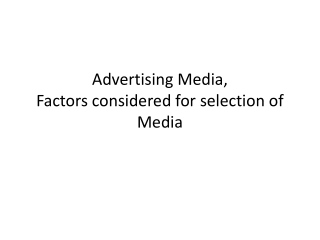Understanding Advertising Media Effectiveness
Advertising effectiveness is crucial for brands to assess the impact of their marketing efforts on target audiences. By measuring strengths, weaknesses, and ROI of advertising campaigns, companies can optimize their strategies for future success. Various approaches such as pre-test, post-test, communication test, sales-effect test, experimental test, and message/media effect test help in evaluating the effectiveness of advertising media.
Download Presentation

Please find below an Image/Link to download the presentation.
The content on the website is provided AS IS for your information and personal use only. It may not be sold, licensed, or shared on other websites without obtaining consent from the author. Download presentation by click this link. If you encounter any issues during the download, it is possible that the publisher has removed the file from their server.
E N D
Presentation Transcript
Measuring Advertising Media Effectiveness
Advertising effectiveness is a method used to determine if a brands marketing efforts are hitting the mark with its target audience and whether it s getting the best returns. It enables brands to measure the strengths, weaknesses, and ROI of specific advertising campaigns, so the company can adjust accordingly. Why should brands measure ad effectiveness? Ad effectiveness is a vital strategy for brands looking to understand the impact of their ads on the audiences they want to influence. It s what helps companies truly understand the reach of their campaigns so they can focus on the elements that were successful and apply them to future efforts.
Approaches to measure Media Effectiveness: There are different tests and several techniques in each of the test to evaluate advertising effectiveness. Test depends on the aspects to be evaluated. 1. Pre-test and Post Test: Pre-test implies testing advertising message before it is sent to specific media. Post test implies testing impact of advertising message after it is published in any of the media. 2. Communication and Sales Effect Test: Communication test measures communicability (ability to communicate) of the message. Whereas sales-effect test measures advertising impact on sales volume. 3. Laboratory and Field Test: Clearly, a laboratory test is conducted in a controlled environment in a limited scale. Respondents are invited in a laboratory to state their response. Quite opposite, a field test is conducted in original setting, artificial climate is not created. It is similar as conducting survey to measure what customers think about company s advertisement.
4. Experimental and Survey Test: Experimental test involves testing advertising effect by conducting test by manipulating independent variable (i.e., advertising efforts) and measuring the effect of the manipulation on other dependent variables like sales, profits, consumer satisfaction, etc. Experimental test may be laboratory or field test. Survey test involved knowing consumers view s through a survey method. 5. Message and Media Effect Test: While message test involves measuring clarity, contents, believability, action ability, etc., of the message, the media test measures effectiveness/ suitability of one or more media.
Mostly, a company is interested to measure advertisements communication effect and sales effect. Therefore, it is worthwhile to discuss communication and sales effect test. Communication and Sales Effect Test: Among several tests, the communication test and the sales effect test are more relevant because success of advertising campaign depends on how far advertising has influenced knowledge, attitudes and preference of the target customers. In the same way, a sales volume is the ultimate aim of all marketing efforts (including advertising). Advertising must increase sales. Therefore, evaluation of advertising effectiveness, in most cases, consists of evaluating communication test and sales effect test.
Methods for Communication Effect Test: Communication effect test seeks to determine whether advertisement is capable to communicate effectively. Following methods are used: 1. Direct Rating Test: In this method, consumers are asked to rate/rank alternative advertisements. They are exposed to different ads and are requested to rate them. Consumers can consider various criteria to rate the advertisement, like message contents, message clarity, coordination, and overall impression. 2. Recall Test: It measures the retention value of ad message. The consumers are asked to listen and/or view the particular advertisement. They are then asked to recall the same. The amount of contents and message they recall determines effectiveness of advertisement.
3. Portfolio Test: Here, the consumers are asked to view and/or listen to a portfolio of advertisements. They are given as much time as they need. They are then asked to recall all the ads and their contents. Their recall level indicates an advertisement s ability to affect consumers knowledge and arouse interest. 4. Laboratory Test: The test is conducted in laboratory. Necessary equipment s are used to measure consumers physical reactions in terms of heartbeat, blood pressure, perspiration, etc., to an ad. Methods Sales Effect Test: While the communication effect test measures communicating ability of the ad, the sales affect test measures ad s ability to influence sales. Ad must affect sales positively. In fact, advertising s sales effect is difficult to test because sales are influenced by many factors besides advertising, including product s features, price, availability, and competition.
Following two methods are used: 1. Historical Test: The test involves correlating the past sales to the past advertising expenditures using advance statistical techniques. The results can reveal how far advertisement was effective in generating or increasing sales. The test can be used for different products, territories and ad media, or in general. 2. Experimental Test: Experiment is conducted to assess impact of advertisement on sales. Instead of spending the same per cent of sales for advertisement in all territories or products, a company spends different percentage of sales for advertisement. Company can easily judge whether high-spending territories have resulted in increasing sales and vice-versa.
The importance of evaluation of the effectiveness of advertising is listed below: (i) It is generally opined that much of advertising expenditure is wasteful. Proper evaluation would help in finding out whether it is really wasteful and if so how much of it is so. (ii) Evaluation reveals the strengths and weaknesses of different media and thus provides useful guidance for future media planning. (iii) Through suitable methods, the draft of a message or a copy can be tested beforehand so that preventive steps may be adopted and waste reduced. (iv) The whole process of evaluation leads to a body of recorded experience which may be useful not only to the improvement of advertising but also to better planning. (v) Evaluation shows not only which advertisements are less productive but why they are so. So it indicates the sources for greater effectiveness.
There are many difficulties in the evaluation of the effectiveness of advertising and they are: (i) Good researchers who can successfully measure the impact of advertising are difficult to get. (ii) It is difficult to say how much increase in advertising resulted in how much rise in sales. (iii) The primary aim of advertising is to increase sales. But it cannot be concluded that the entire increase has been due to advertising. In reality, many factors influence sales, advertising is just one of them. (iv) Advertising has many goals, one of them is to build goodwill. But measurement of goodwill is not possible.























